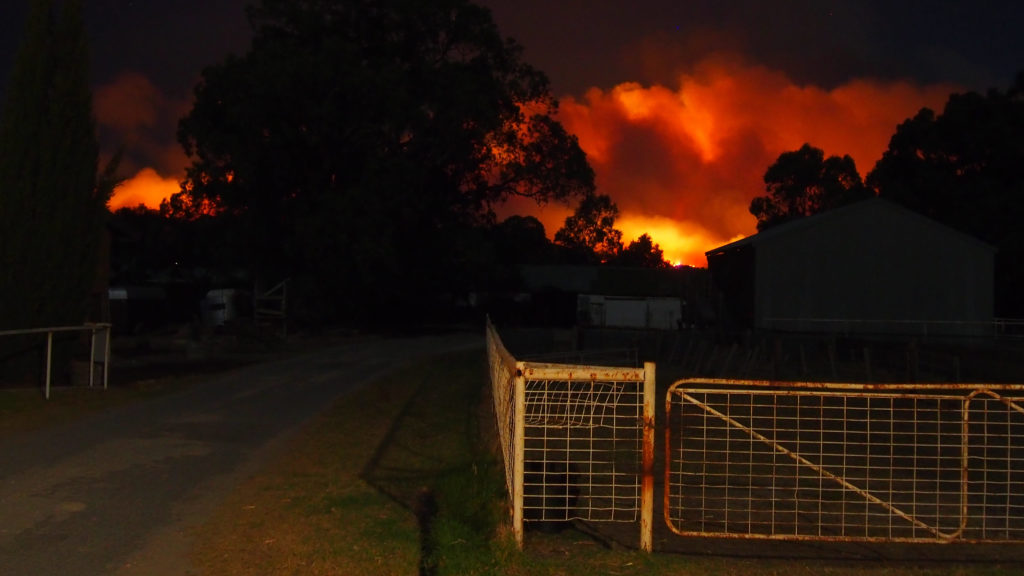
Flume country
South-eastern Australia is one of the most fire-prone regions on the planet, but a persistent lack of connection between culture and place has left its settlements dangerously exposed to disaster time and time again.
Architects have long loved the Yarra Valley, with its majestic mountain ash and tree fern forests, the sinuous billabongs of the Yarra and its tributaries, and the lingering vistas from the escarpments of the Great Dividing Range. This palette has inspired genre-defining buildings and places—think of the TarraWarra Museum of Art and grounds by Allan Powell and Tract, the soaring Denton Corker Marshall View Hill House, or even the heritage-listed 1854 Chateau Yering, the pioneering cellar door of the 19th century. For almost two centuries, art galleries and wineries, boutique hoteliers and gastronomy entrepreneurs have collaborated with the best Australian designers to shape one of the most visited tourist regions in Australia.
It’s easy to forget that on 7 February 2009, the Black Saturday firestorm transformed this bucolic landscape into a theatre of unutterable terror. By the time the last of the flames had been quenched, over a million acres had been blackened, and countless animals, wild and domesticated, had been killed. More than three thousand buildings were destroyed and 7,562 people displaced. In one small village alone, 38 people died, 34 in another, 173 in total. All of them friends, neighbours, family—in some instances, multiple generations of the same family.
Twelve years on, have we really taken the hard-learned lessons to heart? It’s true that some of the region’s newest buildings are not just constructed to minimum Bushfire Attack Level (BAL) requirements, but explore an entirely new class of fire-oriented design—at least that’s what the glossy brochure promotes. Bespoke architecture aside, the lives of most people who inhabit the region might not be faring so well.
Sites where multiple people were killed, specifically those on the crest of a rise (with houses built to take advantage of views) have been replaced with buildings compliant with the bare minimum of fire preparedness required by the codes. Dead-end streets, death traps in Black Saturday, have not yet been opened to through traffic, despite promises from councils. And houses that dodged the flames in 2009, but come nowhere close to current BAL requirements, leave home owners sitting ducks when the next major bushfire roars through.
Kate Cotter, chief executive of the Bushfire Building Council of Australia, believes that over 90 percent of building stock in regional areas is not built to current bushfire building standards. That leaves more than one million homes unable to withstand the fires of the future.
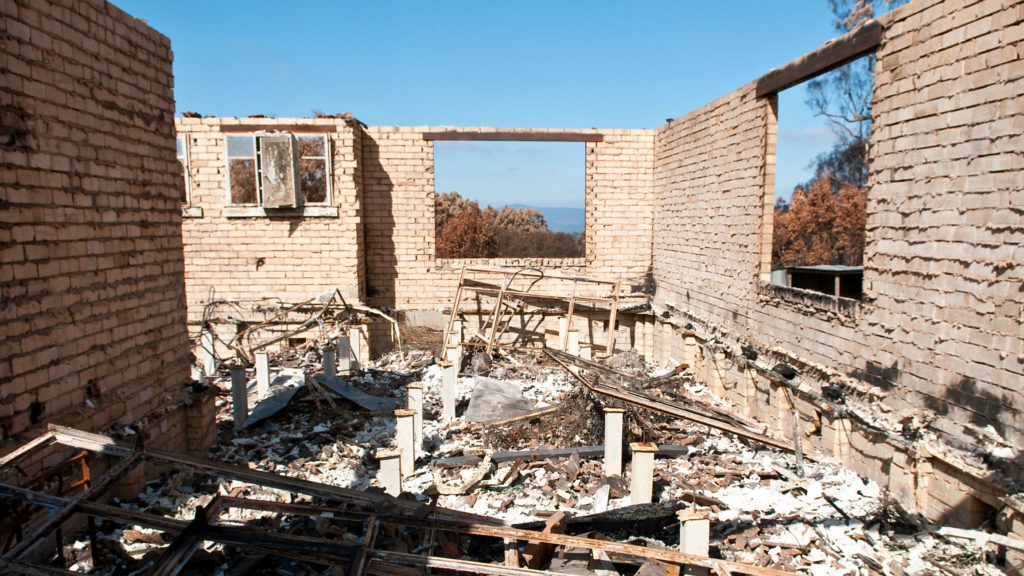
Forgetting fire
Even as the Black Saturday disaster was unfolding, commentators were labelling it ‘unprecedented’. The shocking images of a 15-kilometre-high tower of flame, gas, smoke, and ash, spinning with the ferocity of a cyclone, was nothing like anybody had experienced before. But that doesn’t mean it hadn’t happened before.
Black Friday of January 1939, which burnt through almost exactly the same area was one of the most devastating disasters of the 20th century for Victorians. And it’s worth revisiting William Strutt’s massive masterpiece Black Thursday, February 6th, 1851, hanging in the State Library of Victoria, for a visceral reminder of how freakishly repetitive these large-scale fires are—right down to the date and the temperatures leading up to the fire (reportedly 47.7 on the day). Then there’s 1943, 1952, 1962, 1969, 1977, Ash Wednesday of 1983—and this is just the fires in which lives were lost and houses destroyed. Had we already forgotten that Canberra lost 500 homes in 2005?
Since Black Saturday, we’ve had the Christmas Day fires of 2015 in Wye River, Northern Tasmania in 2016 and now the 2019/2020 summer of fire-hell. In every iteration, the word unprecedented is used to describe our surprise. We are left feeling shocked and betrayed by this benign and bountiful country’s angry turn against us. After all, it’s our home.
No one who directly experienced the Black Saturday disaster wants to keep reliving the moment. A certain amount of forgetting is essential to recovering from trauma and people have every right to heal in whatever way they need to. But we also need to remember.
This tension is tricky to navigate and it’s played out in public memorials across the fire zone, some already decades old—stone circles, sculpture gardens, plaques, cairns, public seating. Some of these memorials to those who lost their lives are exquisitely sad. But research tells us that memorials are not the best way to remember and may even help us forget. It’s as though having commissioned the sculpture, made the garden, landscaped the path, we are free of the obligation to keep the knowledge alive.
What we also need to do is learn about the unique conditions that come together in this part of the planet so we can recalibrate our understanding and better read the signs. This is deep cultural work and the time to start is now.
The devil is in the detail
The iconic cool-climate rainforests of Victoria are fragile and complex ecosystems dependent on the crowns of giant eucalypts—the mighty mountain ash—to protect fern glades and creek beds from the harsh sun. Eucalyptus regnans is one of the tallest tree species in the world. The canopy the trees provide sits well above 100 metres, leaving the forest floor wet and cold in winter and refreshingly dappled in summer. That is until a decade of drought is followed by a once-in-a-generation heat wave—then, a deep biological impulse springs into action.
Like all of its eucalyptus cousins, the mountain ash is dependent on fire to regenerate. But unlike them, it can’t survive a fire. With its masses of leaf litter and long strings of bark that carry flames high into its crown, this tree is not just built to burn but to go out in a blaze of glory. Environmental historian Tom Griffiths calls it ‘an act of mass suicide’, with a fire of unimaginable intensity that spares nothing. This scorched-earth strategy leaves behind a self-prepared ash bed in which new seeds, released from their hard cases by the heat, are able to germinate.
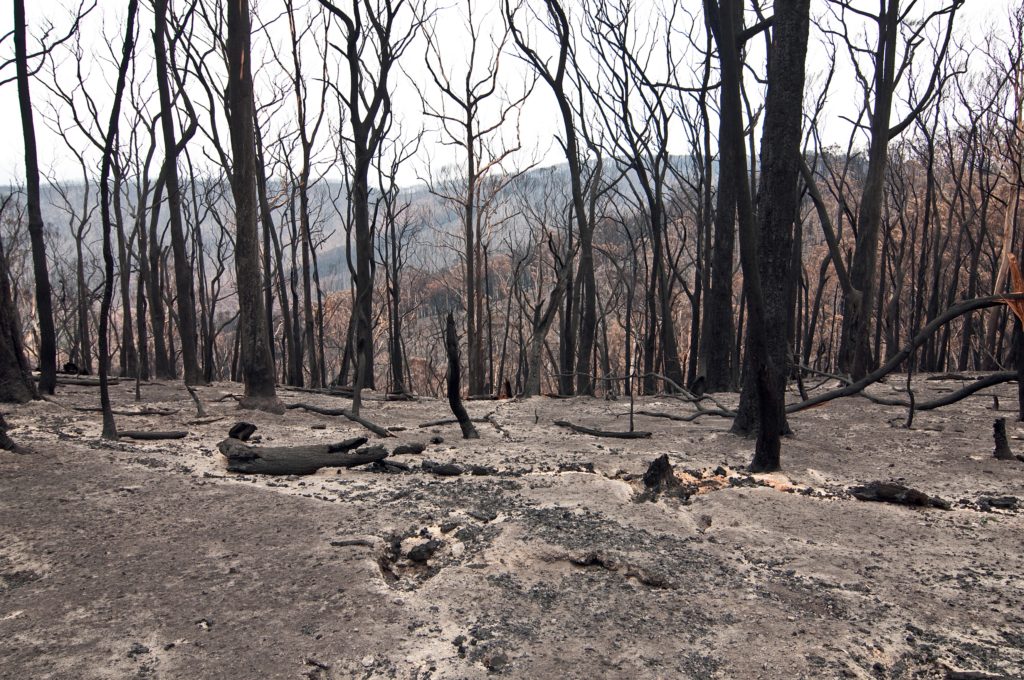
The cycle can’t kick-off without the right conditions and the most necessary of these is drought. Unless the leaf litter is dried to a crisp, any fire will die out as it hits the normally sodden soils. Once the understory is desiccated, it’s ready for the next ingredient: wind. Every Melburnian is familiar with the scorching northerly that scours your eyeballs and blow-dries your washing. These currents are produced by a stalled high-pressure system in the Tasman Sea, which pulls hot air from central Australia across the south-east corner of the country. As the hot air hits the convoluted and heavily vegetated folds of the Great Dividing Range, it is channelled and amplified. And finally, the spark—the impending cool change stuck behind the stalled system supplies the lightning.
US fire historian Stephen Pyne calls this potent combination of geography, vegetation and weather ‘the flume’ and it’s what make south-eastern Australia the most fire-prone region on the planet. The nasty sting in this scenario, the one-two punch as Pyne calls it, is that when the cool change finally arrives, the prevailing winds shift 180 degrees. If a substantial fire has taken hold, then this wind change turns the fire’s long flank into a new front and pushes a massive fire wall back onto areas it has just passed through. It’s almost always this second wave that catches us unawares.
The conditions needed for a fire of the scale of Black Saturday don’t come together all that often. Studies of old-growth forests tell us that mountain ash tends to burn in cycles of somewhere between 150 to 350 years—although with human intervention and a heating climate this window is shrinking. Their life doesn’t always end in fire, but where it does, the cycle sits outside of a human generation.
That alone gives a clue to contemporary Australia’s cultural amnesia. How can we see evolutionary deep time as of immediate importance when colonial Victoria has not yet reached its second century?
The forests themselves promote this amnesia further by ridding themselves of fire scars in most peculiar ways. As soon as the ash-beds cool, mountain ash seeds take the opportunity they’ve been waiting years for and sprout into thickets of saplings. Within a year or two, newly opened vistas are starting to close and within three or four years a green canopy is forming. Further down the slopes, where the forests turn to box and stringybark, epicormic buds shoot out of blackened stumps within weeks of a fire, lathering the denuded landscape in a film of luminous green.
Even if the layers of humus needed for a thriving forest eco-system are still functionally missing, the appearance of health washes over the land. This spectacular adaptation is all part of the magic, a disappearing act that eases us into forgetfulness.
Reading the lay of the land
Our communities spring back in new forms too. We have learned something. Last-resort community fire refuges, buildings built or adapted to survive radiant heat and ember attack, are now doted across the flume. The Tarrawarra Abbey has elevated the fire-proof bunker to high art with a soaring concrete structure comprising communal activity rooms and workshops. This beautiful and functional building holds the story of fire risk firmly in the landscape—on extreme weather days, a green roof of indigenous plantings designed by Aspect Studios can be soaked via a sub-soil irrigation system to help protect the building.
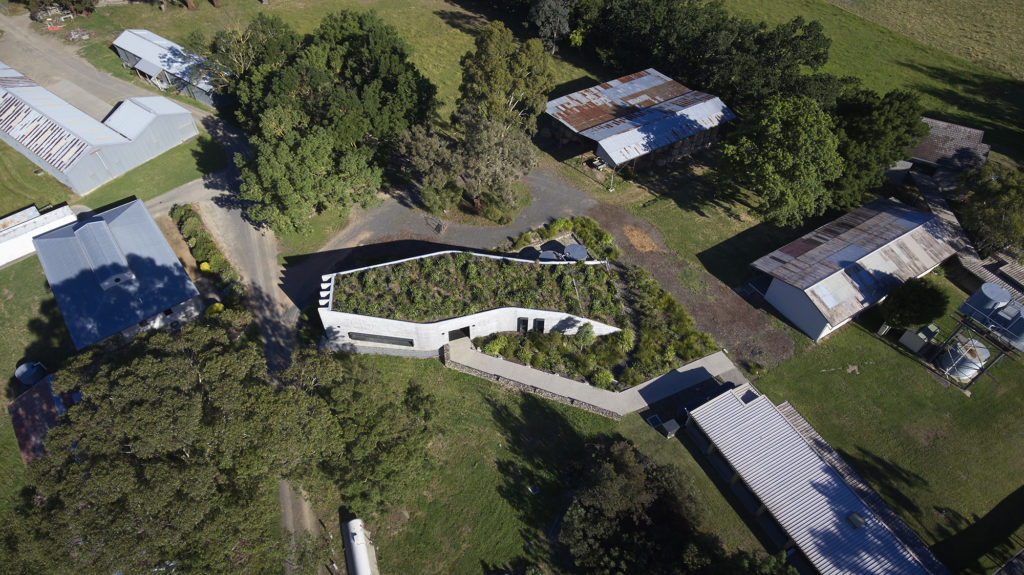
But fire mitigation is an art we’re still learning and there are no guarantees. The luxury Southern Ocean Lodge on Kangaroo Island opened in 2008 with bushfire strategies that were state of the art: on-site water capture, window sill sprinklers, fire-rated materials. In January this year, while staff sheltered in the lodge’s last resort bunker, the entire development burnt to the ground.
We can’t rely on technical fixes alone. We need to diversify our approach if we are to thrive in the flume. Like the E regnans itself, we need to adapt. When we talk of human adaptation, however, we can’t avoid the elephant in the room—we’re talking about European adaptation specifically. Because colonisation was not only a land grab, it was also an act of cultural violence. Knowledge systems that had developed in place for millennia and carried complex environmental information were extinguished when people were no longer allowed to practice their land management techniques or speak their languages.
One of the impositions of the new arrivals was the seasonal calendar. The four seasons— winter, spring, summer and autumn—are a fundamentally alien idea transposed from another reality. When it comes to fire, that’s important. If we think about the drivers behind climate we understand that the quartered year is driven by the Atlantic Gulf Stream and its flow around the northern hemisphere. Australian weather patterns are driven by Pacific Ocean currents and whether we move into or out of drought is driven by the balance of La Niña/El Niño conditions.
The Melbourne Museum has quietly been changing this understanding in its Forest Gallery with an unassuming walkway depicting the Kulin calendar. Victorian children (and adults) are learning that Aboriginal people of the Kulin nation recognised seasons by the life cycles of plants and animals, rather than an abstract evenly-quartered year. The Kulin calendar has six or sometimes seven annual seasons, if they all arrive, and each is of a different duration. Some people say there can be up to 12. The version on display was captured by an ethnology project run by the museum in the 1960s and ’70s and the seasons they recorded were: Luk, Waring, Guling, Poorneet, Buath Gurru, Garrawang and Biderap.
When Iuk (eels) are fat and ready to harvest and the binap (manna gum) is flowering, that’s Luk season. During Waring, the wombats (waring) emerge to bask and graze in the sunshine. That’s when male bulen-bulen (superb lyrebird) perform their courtship displays and the hearts of kombadik (soft tree-ferns) are reading for eating, perfect when no other fruits are available. Guling is when muyan (silver wattles) are flowering and the caterpillars of the brown butterfly feed on the grasses at night. Poorneet, tadpole season, is the time when myrnong, (yam daisy), tubers are ready for eating. Buath Gurru is when buliyong (bats) are catching insects in flight, brown butterflies are flying and the coranderrk is coming into flower. During Garrawang, fruits appear on the kangaroo apple bushes and bundjil (wedge-tailed eagles) are breeding. And Biderap is the dry season, when bowat (tussock-grass) is long and dry.
Sometimes these seasons fail to arrive, or they arrive early, or they continue past their usual duration. But most importantly for this story, in addition to these annual seasons, there are a further two cyclic but non-annual seasons of big water and big fire. Big water happens about every 28 years and big fire happens about every seven years, a pattern that roughly aligns with the La Niña/El Niño rhythm.
Neither of these non-annual seasons come without warning. For example, if Biderap, dry season, has been long and hot for several years and Waring season, the early rains, failed to eventuate, if the kangaroo apple are small and hard, not good for eating or the yam daisy didn’t flower at all, a season of big fire is due. We call it a drought, but even that might be a misnomer. It is a non-annual season of less water, and the forests are priming themselves to be burnt. They are dropping more leaves, dropping more bark. Their wet soils, which normally inhibit fires, are drying out and their seedpods are ripening. They want and need this season. A fire is coming. Prepare.
Of course not every season of big fire produces conditions for a fire storm on the scale of Black Saturday. But thinking back to that 10 years of dry weather, reported on the nightly news in daily increments, if we had had a different lens to look through, one in relationship to local conditions, we might have seen not an aberration known by Europeans as drought, but the inevitable arrival of a non-annual fire season.
These ideas are being picked up by communities throughout the flume region with the aim of instilling a more nuanced understanding of place in the next generation.
One small initiative is the Kulin Calendar Garden planted by St Brigid’s Catholic Primary School in Healesville, where children can follow the local seasons in real time. This is a small project but it has large consequences: a generation of kids will grow up having real experience of how to watch for signs of what’s to come.
We’re also seeing an exponential growth in experiments with cultural burning, the Aboriginal techniques of cool-fire mosaic pattern burns. This work is fascinating and something that should be the focus of our energies. But even if mosaic burning does offer solutions for much of the area burned in the Black Saturday fires, the mountain ash forests will never be part of such a regime.
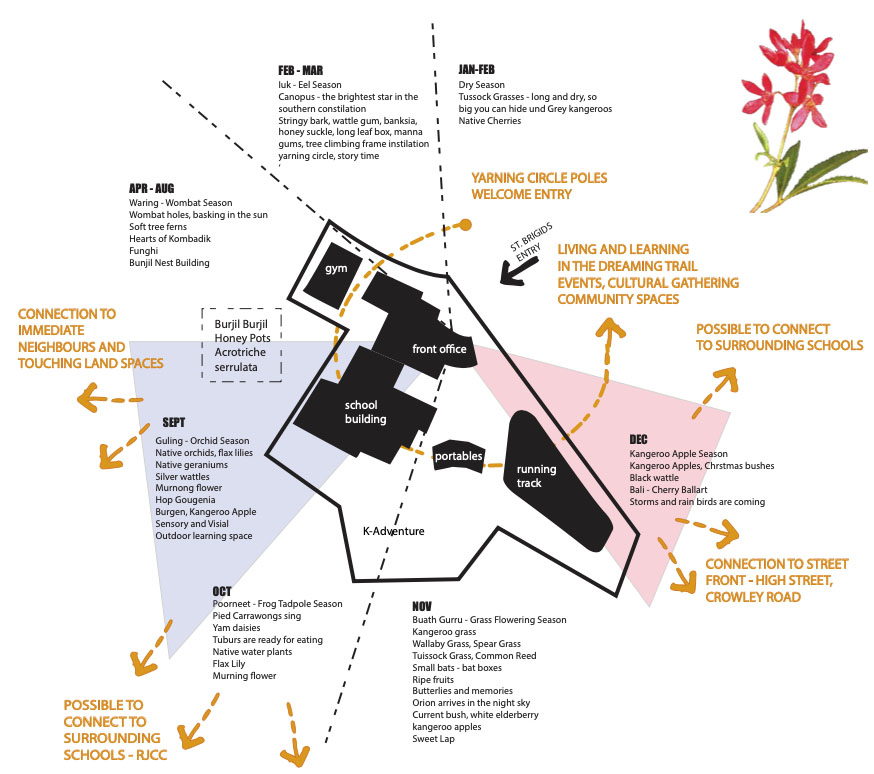
A hotter future
Let’s be blunt: eucalyptus oil has a flash point of 48 degrees Celsius; that is the temperature at which it will give off sufficient vapour to ignite in air. For context, scientists are telling us to prepare for temperatures to regularly hit 50 degrees Celsius by the end of the century.
Knowing as we do that the eucalyptus-dominated ecosystems of south-east Australia are primed to burn, any activity that increases their ambient temperature is knowingly increasing the risk of large-scale bushfire. This is basic science. We can look to the evolutionary biology of the tall forests to understand their historic relationship to fire, but to survive our future—given the climate heating trajectory we’re on and the lack of appetite for real change—we need to prepare. And critical to preparing is to remember.
Safe, smart buildings are part of the mix but are mostly beyond the means of the one million households who live in unsuitable building stock. Memorials are important, but forgetting trauma is too. Community refuges are essential but are yet to be fully tested. And personalised bunkers could well be life-saving on remote properties.
But we can all play a role in creating a safer future, even before we reach for the next infrastructure project. We can champion cultural shifts that bring us closer to the places we live. The antidote to forgetting is to institute not just new building regimes, but new language. If we can unwrap a conversation about what it means to live in the flume, we can work against the forgetting that leaves us vulnerable to being caught by surprise.
Maybe one day we will watch the nightly news report on the failure of Warang and Porneet seasons to arrive and we’ll notice that Bideraup has started early. If that is sustained, we’ll know a season of fire is potentially on the way. These new intimacies will of course flow into how we plan, build and live in the flume and where and when to mitigate against hot fire with cool-fire burns. Most of all, it will start to weave us into the textures and deep time histories of the country we occupy, paying proper respect to the traditional owners whose knowledge systems were tuned to this complex place we now call home.
Christine Hansen has a PhD in History from the Australian National University. She co-authored the book Living with Fire: Black Saturday at Steels Creek (CSIRO 2012) with Tom Griffiths. She is currently the Manager of Knowledge and Content at the Queen Victoria Museum and Art Gallery, Launceston Tasmania and a research scholar at the Department of Historical Studies, Gothenburg University, Sweden.


